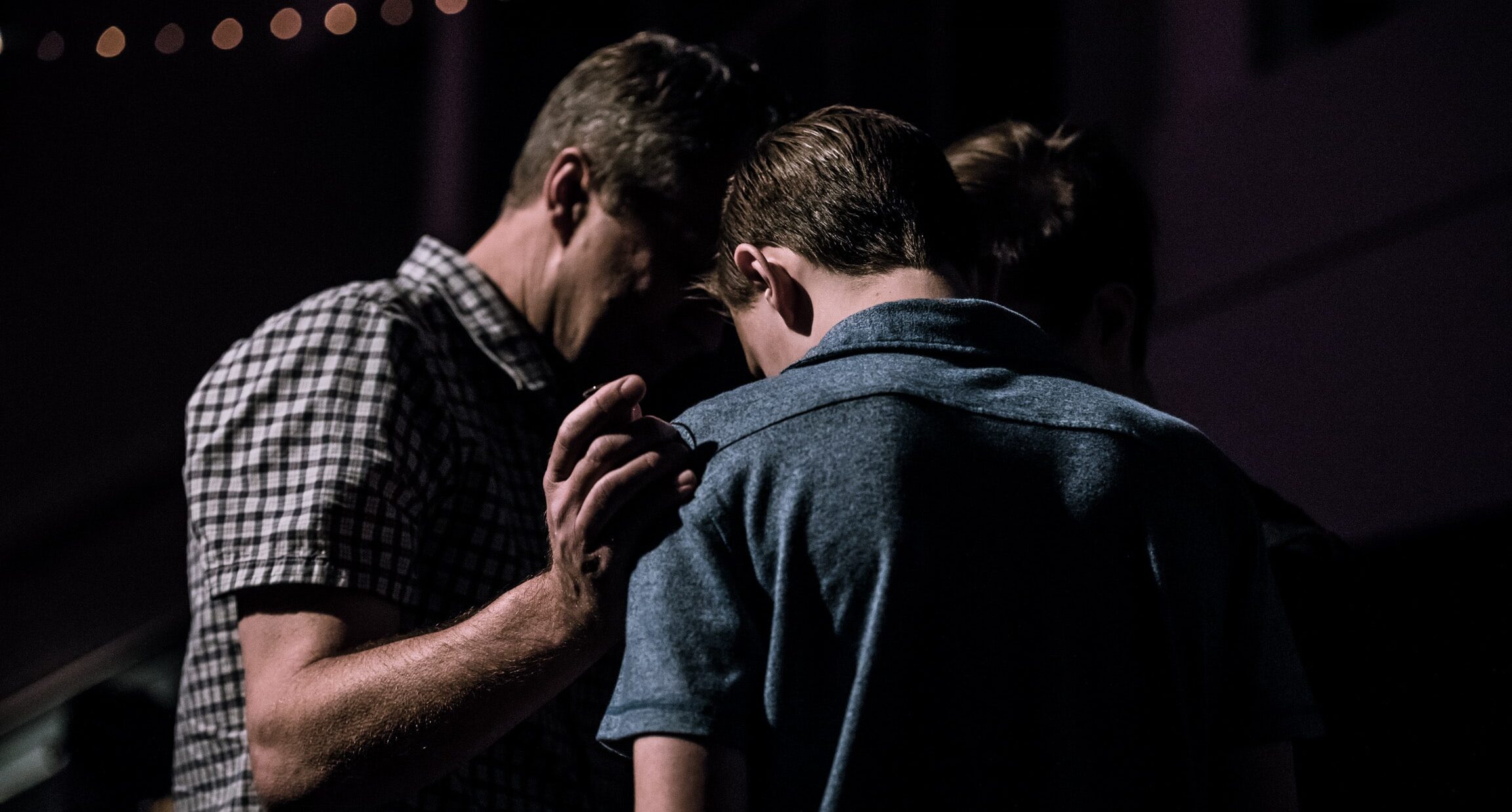Step One—Prayer of Silence
Listening Prayer uses silence as a way of consciously making space for God. Silence is less about not talking and more about having a posture of open, attentive listening for God. Group Listening Prayer typically begins with a longer period of silence. This might be ten to fifteen minutes. If the group is already in a quiet retreat frame of mind, the opening silence might be for only ten minutes. The mentor or chosen peer facilitator may light the candle and say, “Be still and know that I am God” or offer another Scripture as a way of leading the group into silence, if they wish. The silence gives everyone time to still the inner chatter in their minds and turn their loving attention to God by gazing on him and receiving his loving gaze on us. In that inner place of love, group members also have time to listen to their own souls to discern what the Spirit might be stirring that they want the group to consider in prayer.
Step Two—First Sharing
After the initial silence, one member begins sharing what they want the group to consider. In Mentoring Communities, usually an hour is set aside for each person. Half of the time is for the person to share whatever they have on their heart to share. Usually, there is a review of what happened since the last time the group met and then a reflection on what is needed for discernment and prayer now. If the group is meeting for the first time, it is important for the person sharing to tell their spiritual story (to acquaint the group with their lives and ministries), then reveal their core concern.
What God is working in our souls is often different from what is happening externally in our lives. This is what we want to hear from one another. This is what we want to lift up to God for one another.
Tweet
Remarkably, the sharing and prayer requests that come after a period of silence are different from what comes when we ask for prayer requests without that space for listening. Without centering silence, many of us lack easy access to the deeper needs of our souls, so we are more inclined to share pressing-but-less-significant concerns: “My dad is dying—pray for my dad” rather than “My dad is dying, and my mom is pushing all my buttons.” What God is working in our souls is often different from what is happening externally in our lives. This is what we want to hear from one another. This is what we want to lift up to God for one another.
Sharing in Listening Prayer does not require lots of details. Whatever helps to convey the essence of the sharer’s heart concern is needed, but not all the details surrounding it. Listeners can ask a clarifying question but only if it helps bring understanding. If some part of the sharing was confusing, a group member might ask for clarification. After all, we will be lifting this person to God, and God knows everything, so we don’t need every bit of information.
Every person in the group who is not sharing at this point is a listener and a person of prayer. The whole time of listening to someone, while they are talking and during silence, is with an attitude of attentiveness to the Spirit. As we listen to a person sharing, we have one ear to the person and the other ear to God. The only person talking is the person sharing.
Step Three—Listening Silence on Behalf of the Person Who Shared
After a person has shared, the entire group returns to silence. The mentor or facilitator might say, “Let us return to silence to lift this person into the light and love of God and listen for God’s prayer for them.” This silence usually lasts five to eight minutes. Listeners are like the friends of the paralytic that we read about in Mark 2:1-12. They let their friend down before Jesus. In silence, the person who shared is lifted into God’s light. Listening starts from the assumption that God knows and loves this person completely, so we do not need to tell God what he already knows. Listening also starts with the assumption that Jesus is at the right hand of God, interceding for the one who shared (Romans 8:34). The group seeks to join in the prayer of Jesus for this person. In the silence, listeners are not telling God what they think the one who shared need; rather, they are attentively listening for a sense of what God’s prayer might be for this person. Just having a few friends lovingly hold an individual before God is gift enough.
Step Four—Response to the Person Who Shared
The facilitator breaks the silence with a bell or by saying “Amen.” After silence for listening, those who have been listening are invited to share anything that they experienced. Sometimes in the listening, a Scripture, image, or song might arise. It is also common for the mind to wander from this person’s sharing to our own, similar experiences, or to begin concocting advice for the person, or even to reflect on passages of Scripture that their story evoked for you. Acknowledge and move on from these wanderings. They are to be distinguished from the word or image or Scripture that the Lord might bring to your mind for this person. We hold these things before God during this time of silence to see if they continue to resonate.
Those who share their listening experiences must let go of things they feel are just their own best idea or response and use this time only to share what seems to come from prayerfulness. In addition, this is not the time to extend the sharing by telling stories or having the one who shared say more. The listeners should be sharing, not the talker. A simple offering of an image, word, or prayer that has come is sufficient. It is very helpful when someone offers to take notes on what is shared on behalf of the one who shared. This allows the sharer to listen fully to the one speaking but also preserves what was spoken.
We offer our love and prayers in love. Sometimes something resonates profoundly. Other times, the surrounding love of prayerfulness is gift enough. What is key is that we have listened attentively and deeply to one another with a prayerfulness to God.
Tweet
In addition, there is no need for the offerings to necessarily make clear sense. The “if you build it, they will come” line given to me after silence made sense to me, even though it didn’t to the person who shared it! Also, offer what comes without a sense of a strong prophetic voice but rather as a humble, gentle offering. Allow the sharer to discern what resonates with the Spirit for them. This is listening for only a few minutes by a gathered community of humble believers. We offer our love and prayers in love. Sometimes something resonates profoundly. Other times, the surrounding love of prayerfulness is gift enough. What is key is that we have listened attentively and deeply to one another with a prayerfulness to God.
Step Five—Prayer for the Person Who Shared
After hearing the responses, the person who shared can offer any final comments, if they wish. Then the mentor or peer facilitator asks who would like to pray for the one who shared. Someone volunteers to pray. It is helpful to lay hands on the one who shared while praying aloud as a way of expressing the group’s love and involvement in the prayer. The brief spoken prayer places the needs and responses in God’s care.
Step Six—Return to Silence
At the end of the prayer, it might be helpful to see if anyone needs a short break. If two or three people will be listened to in the span of a determined amount of time, it is helpful to take a little break to stretch, get a drink, or use the facilities. This should only be five minutes. If a break is not needed, the group returns to a short silence, out of which the next person can share.
Step Seven—Repeat the Process
The process of one person sharing, group silent Listening Prayer, offering responses, and final prayer continues until everyone in the group has had an opportunity to share and have prayer with the group. At the end, it’s helpful to take a few minutes to reflect on the group’s prayerfulness as a group. This can help an ongoing group learn as they go and note any concerns or ways they might need to grow. The facilitator can bring the time to conclusion with a collectively spoken Lord’s Prayer or a simple prayer or benediction.
This excerpt is from Lifelong Leadership: Woven Together through Mentoring Communities by MaryKate Morse. You can purchase the book at your favorite bookstore.



